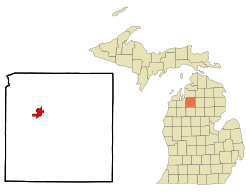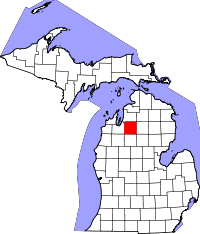Kalkaska, Michigan
| Kalkaska, Michigan | |
|---|---|
| Village | |
 Location of Kalkaska, Michigan | |
| Coordinates: 44°44′4″N 85°10′48″W / 44.73444°N 85.18000°W | |
| Country | United States |
| State | Michigan |
| County | Kalkaska |
| Township | Kalkaska |
| Government | |
| Area[1] | |
| • Total | 3.17 sq mi (8.21 km2) |
| • Land | 3.12 sq mi (8.08 km2) |
| • Water | 0.05 sq mi (0.13 km2) |
| Elevation | 1,033 ft (315 m) |
| Population (2010)[2] | |
| • Total | 2,020 |
| • Estimate (2012[3]) | 2,017 |
| • Density | 647.4/sq mi (250.0/km2) |
| Time zone | Eastern (EST) (UTC−5) |
| • Summer (DST) | EDT (UTC−4) |
| ZIP code | 49646 |
| Area code | 231 |
| FIPS code | 26-42260[4] |
| GNIS feature ID | 0629450[5] |
Kalkaska (pronounced /kælˈkæskə/) is a village in the U.S. state of Michigan. The population was 2,020 at the 2010 census. It is the county seat of Kalkaska County.[6] The village is part of Kalkaska Township.
Geography
According to the United States Census Bureau, the village has a total area of 3.17 square miles (8.21 km2), of which 3.12 square miles (8.08 km2) is land and 0.05 square miles (0.13 km2) is water.[1]
The village is situated on an expansive plateau, along with much of Northern Michigan. The Boardman River runs through the village. The primary geography of the north and east of the village proper is flat with gentle hills, with a large amount of farmland. To the south and east, it is noticeably steeper in elevation, with larger amount of water present in the form of streams, to the north a larger amount of water is present in the form of lakes.
The primary constructors of Kalkaska's geographical make-up are ancient glaciers, along with the majority of the entire state of Michigan. Glaciers scoured the surface of Michigan during the Ice Age, creating small hills called drumlins, along with valleys and basins and the water that currently occupies them. This process is called glaciation.
Kalkaska experiences a notable amount of snowfall as it is located in a snowbelt that receives heavy amounts of lake effect snow from Lake Michigan.
Kalkaska is considered part of Northern Michigan.
Climate
This climatic region has large seasonal temperature differences, with warm to hot (and often humid) summers and cold (sometimes severely cold) winters. According to the Köppen climate classification system, Kalkaska has a humid continental climate, abbreviated "Dfb" on climate maps.[7]
Demographics
| Historical population | |||
|---|---|---|---|
| Census | Pop. | %± | |
| 1880 | 496 | — | |
| 1890 | 1,161 | 134.1% | |
| 1900 | 1,304 | 12.3% | |
| 1910 | 1,415 | 8.5% | |
| 1920 | 866 | −38.8% | |
| 1930 | 861 | −0.6% | |
| 1940 | 1,132 | 31.5% | |
| 1950 | 1,250 | 10.4% | |
| 1960 | 1,321 | 5.7% | |
| 1970 | 1,475 | 11.7% | |
| 1980 | 1,654 | 12.1% | |
| 1990 | 1,952 | 18.0% | |
| 2000 | 2,226 | 14.0% | |
| 2010 | 2,020 | −9.3% | |
| Est. 2015 | 2,038 | [8] | 0.9% |
2010 census
As of the census[2] of 2010, there were 2,020 people, 871 households, and 482 families residing in the village. The population density was 647.4 inhabitants per square mile (250.0/km2). There were 1,015 housing units at an average density of 325.3 per square mile (125.6/km2). The racial makeup of the village was 95.6% White, 0.6% African American, 1.3% Native American, 0.6% Asian, 0.2% from other races, and 1.7% from two or more races. Hispanic or Latino of any race were 1.8% of the population.
There were 871 households of which 29.2% had children under the age of 18 living with them, 33.4% were married couples living together, 16.0% had a female householder with no husband present, 6.0% had a male householder with no wife present, and 44.7% were non-families. 38.6% of all households were made up of individuals and 18.3% had someone living alone who was 65 years of age or older. The average household size was 2.22 and the average family size was 2.90.
The median age in the village was 37.9 years. 23.4% of residents were under the age of 18; 9.8% were between the ages of 18 and 24; 25.3% were from 25 to 44; 24.3% were from 45 to 64; and 17.1% were 65 years of age or older. The gender makeup of the village was 46.9% male and 53.1% female.
2000 census
As of the census[4] of 2000, there were 2,226 people, 881 households, and 540 families residing in the village. The population density was 890.7 per square mile (343.8/km²). There were 969 housing units at an average density of 387.7 per square mile (149.7/km²). The racial makeup of the village was 96.32% White, 0.67% African American, 1.03% Native American, 0.72% Asian, 0.04% from other races, and 1.21% from two or more races. Hispanic or Latino of any race were 0.94% of the population.
There were 881 households out of which 33.7% had children under the age of 18 living with them, 38.3% were married couples living together, 18.3% had a female householder with no husband present, and 38.6% were non-families. 32.8% of all households were made up of individuals and 14.3% had someone living alone who was 65 years of age or older. The average household size was 2.35 and the average family size was 2.94.
In the village the age distribution of the population shows 26.1% under the age of 18, 10.6% from 18 to 24, 26.7% from 25 to 44, 19.4% from 45 to 64, and 17.2% who were 65 years of age or older. The median age was 35 years. For every 100 females there were 88.3 males. For every 100 females age 18 and over, there were 82.5 males.
The median income for a household in the village was $27,891, and the median income for a family was $33,651. Males had a median income of $26,901 versus $19,333 for females. The per capita income for the village was $13,028. About 15.3% of families and 16.4% of the population were below the poverty line, including 19.7% of those under age 18 and 19.4% of those age 65 or over.
Major highways
History
The town was platted in 1873 by A. A. Abbott and R. L. Thompson, who owned a sawmill, and who correctly anticipated the arrival of the railroad.
On July 5, 1908, a fire began in the middle of the business block and burned most of the stores. Local photographer E. L. Beebe made a number of photographs of the fire, and the resulting postcards were widely sold, and can still be found today. Two years later, in 1910 another fire started in downtown Kalkaska. Again, in 1925 downtown Kalkaska was devastated by the largest fire since the Fire of 1908.
In 1916, the noted author Ernest Hemingway visited and fished in Kalkaska, and later immortalized the town in his story "The Battler". A historical marker has been placed at the Rugg Pond Dam, on the Rapid River, where Hemingway reportedly fished one night from the power house.
On July 10, 1951, the Kalkaska State Bank was robbed by an armed man, who fled and later attempted to escape on foot through a nearby swampy area. After three days of what was termed the largest manhunt in Northern Michigan history, involving the FBI and local and state authorities, the gunman was captured south of the town. Named Raymond J. Turcotte, he had a long string of prior convictions, including manslaughter. Turcotte confessed to the bank robbery and served 18 years in the Michigan State Prison in Jackson, including a term for escape in 1961.
Discovery of natural gas and oil in the area during the 1970s lead to significant growth for the village; however, the growth has since subsided.
In 1993, the Kalkaska schools made national headlines when a financial crisis resulted in a two-month-long closure. Subsequent funding reform improved the outlook for Kalkaska and similar small rural districts in Michigan.
In 2014 Walmart announced plans to open a store in Kalkaska. Previously the closest store was in Traverse City, 25 miles (40 km) away. There was a debate in Kalkaska on whether the community's small town character can be preserved.[10]
Education
Schools are a part of Kalkaska Public Schools.
Travel and recreation
The many surrounding Lakes and streams lure travelers into the village. Kalkaska offers two major festivals, the National Trout Festival at the end of April, and the WinterFest which is held in January.
The first weekend of November brings with it the Iceman Cometh biking challenge. Kalkaska hosts the starting line for a 27.2 mile off-road biking race that runs from the heart of the village to Traverse City along the VASA Trail. The turnout for the race very easily doubles the population within the village, numbering in the several thousands. For mountain biking enthusiasts, this is a famous race, and completing the race is an achievement in itself.
The village has several parks, including the newly expanded KART trail which is planned to be connected with the TART Trail.
Sports
Kalkaska is the home of the Kalkaska Rhinos Junior Hockey Team. They currently compete in the United States Premier Hockey League, an American Tier III Junior A league. This organization is run by former NHL player of 12 years and 2000 New Jersey Devils Stanley Cup winner Krzysztof Oliwa. To date, he is the only player from Poland to have won a Stanley Cup.
Industry
Oil and gas, manufacturing, and tourism are important industries in the village and surrounding county.
Fishermen are attracted to Kalkaska by the many lakes and the Boardman, Rapid, and Manistee Rivers. Kalkaska has held the National Trout Festival in the last week of April each year since 1933. There is a giant statue of a brook trout in the town square. New York Times featured author Jim Harrison wrote about the Trout Festival in his 1991 book Just Before Dark: Collected Non-fiction.
Notable people
- Emil Frisk (1874–1922), professional baseball player for the Cincinnati Reds, Detroit Tigers, and the St. Louis Browns from 1899 to 1907
- Betty Wanless (1928–1995), All-American Girls Professional Baseball League player
- Ron Winter, former NCAA and NFL official
Trivia
A map of Kalkaska is featured on the cover of Problem Solving with C++ by Walter Savitch, the Seventh Edition (Pearson International Edition). ISBN 978-0-321-54940-2, ISBN 0-321-54940-6.
References
- 1 2 "US Gazetteer files 2010". United States Census Bureau. Retrieved 2012-11-25.
- 1 2 "American FactFinder". United States Census Bureau. Retrieved 2012-11-25.
- ↑ "Population Estimates". United States Census Bureau. Retrieved 2013-06-03.
- 1 2 "American FactFinder". United States Census Bureau. Retrieved 2008-01-31.
- ↑ "US Board on Geographic Names". United States Geological Survey. 2007-10-25. Retrieved 2008-01-31.
- ↑ "Find a County". National Association of Counties. Retrieved 2011-06-07.
- ↑ Climate Summary for Kalkaska, Michigan
- ↑ "Annual Estimates of the Resident Population for Incorporated Places: April 1, 2010 to July 1, 2015". Retrieved July 2, 2016.
- ↑ "Census of Population and Housing". Census.gov. Retrieved June 4, 2015.
- ↑ Carlisle, John. "Wal-Mart plan for Kalkaska store draws mixed reaction" (Archive). Detroit Free Press. November 16, 2014. Retrieved on July 3, 2015.
Further reading
- Jobst, Jack. "Gone Fishin'", Michigan History Magazine, November/December 1995.
- Hemingway, E. The Complete Short Stories of Ernest Hemingway. Simon and Schuster, 1998. ISBN 0-684-84332-3.
External links
- Kalkaska Village website
- Kalkaska Police Department
- Leader & the Kalkaskan
- Kalkaska fire
- Postcards of the fire
Coordinates: 44°44′03″N 85°10′33″W / 44.73417°N 85.17583°W
